
|

|
| Cover Page | Table of Contents | Prev Page | Next Page |
Director's Statement
Mission Statement:
The Institute for Crustal Studies fosters research focused on: 1) the evolution of the earth from its inception to present; 2) characterization of the physical, chemical, and biotic processes that modulate that evolution and control the distribution of natural resources; and 3) interactions among the solid earth, hydrosphere, atmosphere, and biosphere, including humans, that shape the earth's surface and impact society. This research encompasses intervals ranging from the duration of an earthquake to the time required to create a continent and relies on collaborative efforts among geologists, physicists, geographers, and chemists.
Director's Statement
Mission and Goals. Two overarching goals encompass most research conducted through the Institute for Crustal Studies: the first is to foster interdisciplinary research that broadens understanding of the evolution of the Earth from a geological, biological, and climatological perspective; and the second goal promotes research focused on the modern and recent processes that shape the Earth's surface and directly impact society. Topics like the assembly and break-up of continents and the evolution of life fall into the first category; whereas the second ranges from earthquake dynamics to water resources and climate change. With respect to the public, ICS promotes efforts to improve the teaching of science, to broaden communication to the public, and to guide the agenda of major research programs at the national or international level.
Evolution of Goals through Time. The Institute for Crustal Studies was initially conceived as an interdisciplinary unit focused on the Earth's crust: the evolution of the crust through time and space, the natural resources contained within the crust and at its surface, and the natural hazards that result from geological processes acting within it. Each of these topics remains a focus of considerable research at ICS. Over the past decade, the ICS research agenda has expanded to include a greater emphasis on landscape evolution, active tectonics, geomorphology, the evolution of life, astrobiology, and geologic education. Much of this expansion results from changes in the research personnel (recent appointees versus departing professors, research scientists, post-docs, and graduate students) affiliated with ICS, but some is a consequence of the transfer of grants and their administration from the former Department of Geological Sciences to ICS in 2001. Moreover, topics that are perceived to have greater societal relevance are receiving enhanced federal funding now in comparison to more "traditional" topics. Researchers at ICS both respond to and help to drive that trend.
One pervasive theme in most ICS studies has been and remains an emphasis on time and the development of a temporal context within which to define events, rates, and interactions at scales ranging from seconds to billions of years. Many ICS projects involve the study of "deep time", the interval spanning from prehistoric times to the origin of the Earth. This emphasis on a temporal context and time scales that commonly bridge millions of years sets many geologic-based studies apart from most other sciences. Reliable reconstructions of past events provides not only an understanding of how the Earth evolved, but also a template with which predictions can be made. Reconstruction of past climatic, tectonic, or biotic changes and the responses to those changes enables an informed assessment of the potential impacts of future changes.
A persistent goal of ICS has been to facilitate the smooth submission and administration of external grants in order to minimize the time and effort researchers must spend on essentially administrative activity. Similarly, in computing, ICS personnel make a concerted effort to anticipate problems, implement solutions, and stay current of rapidly evolving technologies. Whereas room for improvement always exists, researchers who have left ICS for academic appointments at other universities consistently report that they greatly miss the efficiency, timeliness, and friendliness of the grants administration and computational services of ICS.
Contributions to UCSB. ICS provides an environment that promotes interdisciplinary research and facilitates scientific problem-solving that benefits from the integration of diverse expertise. For example, ongoing collaborations between researchers from Physics, Earth Science, Material Science, and Geography (among others) are exploring problems ranging from earthquake dynamics and complex systems to offshore oil seeps and greenhouse gases.
ICS researchers are bringing in new instrumentation, often for multi-disciplinary studies, that enhances the research capabilities of UCSB. Last year, a new electron imaging facility was funded by NSF and is currently fully operational. This year a new cosmogenic nuclide processing facility is being built under the supervision of Bodo Bookhagen in Geography. This facility will serve graduate students and faculty in Geography, Earth Science, and Bren. A major upgrade in instrumentation for high-resolution dating of ancient rocks has been undertaken under the supervision of Brad Hacker and new faculty member (2009) John Cottle in Earth Science. A new, state-of-the-art facility for both thermal ionisation mass spectrometry (TIMS) and multi- and single-collector inductively-coupled plasma mass spectrometry (ICP-MS) is being developed. Both the single- and multi-collector ICP-MS instruments can be coupled with a new femtosecond laser ablation system. This new instrumentation will catapult UCSB into the forefront of analytical capabilities on the global scene and should underpin an expanded array of research projects that can be pursued on campus.
Research scientists in ICS commonly participate in teaching courses through the Department of Earth Science. Many of the post-docs in ICS play a vital role in advising and educating graduate students via short courses and participation in graduate seminars. Over the past four years, an average of 40 graduate students have participated in and been supported by ICS research projects. With support from NSF, researchers from ICS take undergraduates, both as individual field assistants and in coordinated groups, on off-campus research experiences to sites in Antarctica, Asia, and New Zealand.
Evolving Research Trends. Over the past decade, the focus of ICS researchers on more recent aspects of Earth history has increased. ICS-administered research on earthquake dynamics, active tectonics, hydrology, geomorphology, landscape evolution, and climate change now commonly encompass time scales ranging from the present back to 1000s of years. The reasons for this shift are multi-fold: the record of change (both historical and geological) is increasingly complete when approaching the present; the more recent record is commonly most relevant for examining societal impacts; and the nature of interactions among different components of the Earth system is most clearly analyzed when the record is most detailed and complete.
Some problems, however, cannot be reasonably addressed in this modern time frame or setting. For example, processes that happen over millions of years and deep within the Earth, evolutionary change before and after catastrophic events, and conditions with no modern analogue require careful reconstruction of the geologic record of the often distant past and are essential components of efforts to understand Earth history. These represent a persistent focus of many ICS researchers.
Public Outreach and Impact. Two ongoing ICS projects highlight an emphasis on improved teaching and communication of integrated Earth Science to the public. One is focused on development of online tools to support scientific inquiry, writing, and exploration in Earth Science. This integrates exploration of digital data sets with data analysis and synthesis and is pioneering innovative techniques for "calibrated peer review" of student writing. Another project involves the Education Multimedia Visualization Center and has been focused on creating graphics and movies that capture provocative aspects of Earth history, evolution, and site-specific phenomena, such as animations that can be used in national parks. Outreach with the Santa Barbara Natural History Museum and local schools is ongoing.
Whereas no integrated policy-oriented effort currently exists among ICS researchers, numerous ICS participants work individually and in small teams to guide scientific policy and research agendas at the state, national, and international level. Several members work on guidance and oversight committees for Earthscope (the largest initiative in solid earth sciences ever in the US), others guide the scientific agenda for the Southern California Earthquake Center (one of the most successful STCs in the country), and still others are setting research agenda for the International Atomic Energy Agency's use of geochemical tracers.
Highlights from 2007-2008. Personnel changes. Two senior faculty in Earth Science who were strong contributors to ICS retired this year: Tanya Atwater and Jim Boles. Tanya has been in leader in educational outreach and scientific visualization through animations. Jim brought expertise in sedimentary systems, hydrocarbons, and rock-water interactions, as well as being a strong field geologist. Both will be greatly missed! Bodo Bookhagen, a former ICS postdoc, joined the Geography department in January, 2008. His interests focus on Quaternary climate changes and their impact on geomorphic, landscape evolution, erosion, and tectonic processes. He brings diverse expertise in remote sensing, cosmogenic nuclides, and numerical modeling. Another new faculty member has been recruited to Earth Science and will join ICS next year. New Zealand native John Cottle is an expert in collisional mountain building and in mass spectrometry who will greatly strengthen tectonics research at ICS. We are also very pleased by one "non-change" in personnel. Brad Hacker was recruited by Stanford this past year. His successful retention at UCSB laid the foundation for the upgraded geochronologic facilities described above, as well as retaining a world-recognized leader in tectonics research.
Events. Bruce Luyendyk, former ICS director, organized the 10th International Symposium on Antarctic Earth Science. Occurring every four years, this meeting was hosted at UCSB from August 26-31, 2007. Over 350 researchers to UCSB, presented talks and posters on topics including climate change, biotic evolution, magmatic processes, surface processes, tectonics, geodynamics, and the cryosphere. The symposium resulted in 108 peer-reviewed papers and 217 extended abstracts that are published online (http://pubs.usgs.gov/of/2007/1047/) and in a proceedings book by The National Academies Press.
The high quality of research emerging from participants in ICS is exemplified by several scholars and projects.
- Cathy Busby continued her research on the evolution of the Sierra Nevada with a focus on Miocene volcanism and spectacular paleocanyons that once drained rivers sourced in Nevada across the nascent range.
- Jim Mattinson's work on improved methodologies for dating of zircon have provided technological breakthroughs that are now being employed
by the best labs around the world. Using clever combinations of annealing zircon grains and chemical dissolution, Jim has discovered ways
to greatly reduce the sources of error in zircon ages. His techniques result in radiometric ages that have much, much smaller uncertainties
than previously possible. Such fine temporal resolution now enables geologists to decipher and discriminate the timing and pace of ancient
events in greater detail than ever before.
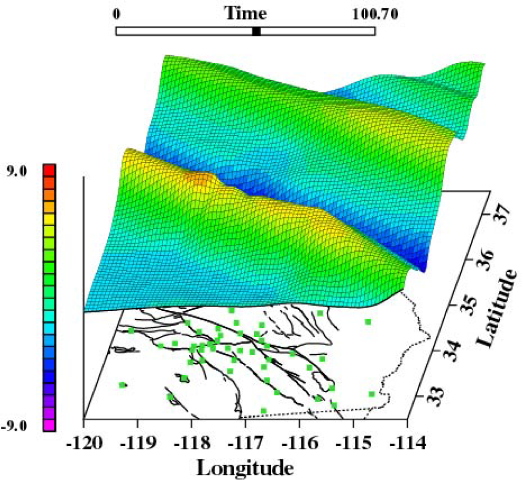
Seismic wavefield in southern California
-
Toshiro Tanimoto has developed new methods for visualizing seismic wavefields as they propagate across a region. By exploiting the high
density of seismic recording stations in southern California, Toshiro is able to illuminate ways in which the underlying crustal structure
interacts with seismic energy to produce displacements at the surface. Such information is valuable both for revealing the rocks deep beneath
our feet and for understanding the spatial variations in how seismic energy is expressed at the surface.
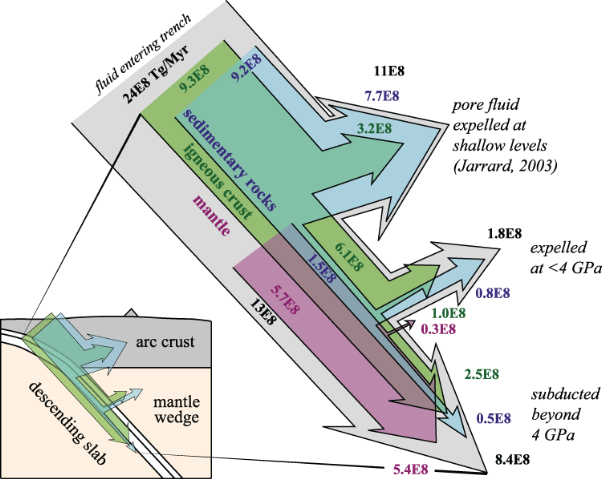
Sources of deep water in subduction
- Whereas several ICS researchers focus on water at the Earth's surface, Brad Hacker has developed a new synthesis of the fate of water in the deep Earth as water, often in the form of hydrous minerals, is transported downwards along subduction zones. This work reveals the roles that terrigenous sediments, altered volcanics, and lower crustal rocks play in carrying water to the deep Earth. One striking result is the differences in the water budgets of various subduction zones around the world.

Model for Miocene explosive volcanism
Overview of the Year. External funding to ICS has averaged about $3.0M/yr over the past 4 years, with the past year being a bit above average. The total value of awards administered by ICS has decreased somewhat in the past year.
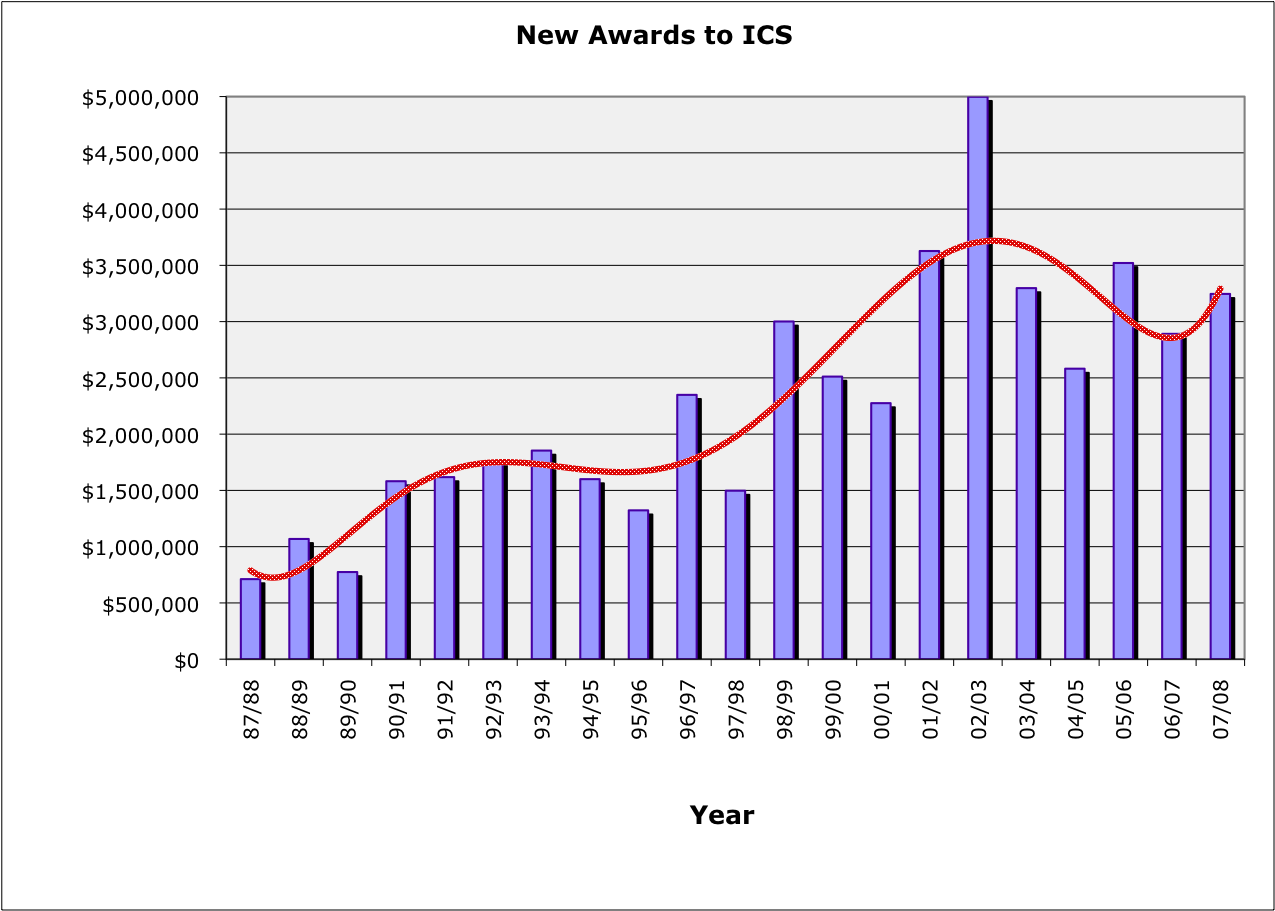
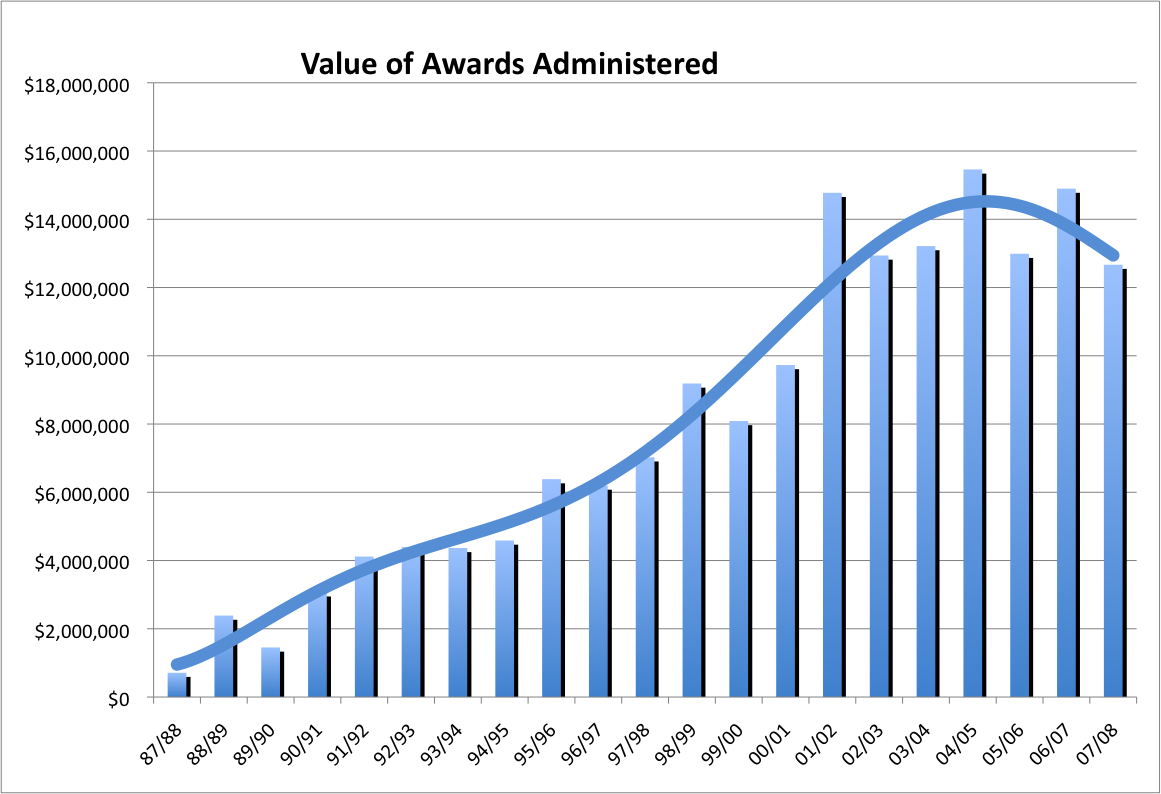
Most other grant-related statistics reveal the impact of two coeval trends that continued into the past year. The recent
retirements of 5 ICS-related faculty in the Dept. of Earth Sciences has depleted the number of individuals submitting grants
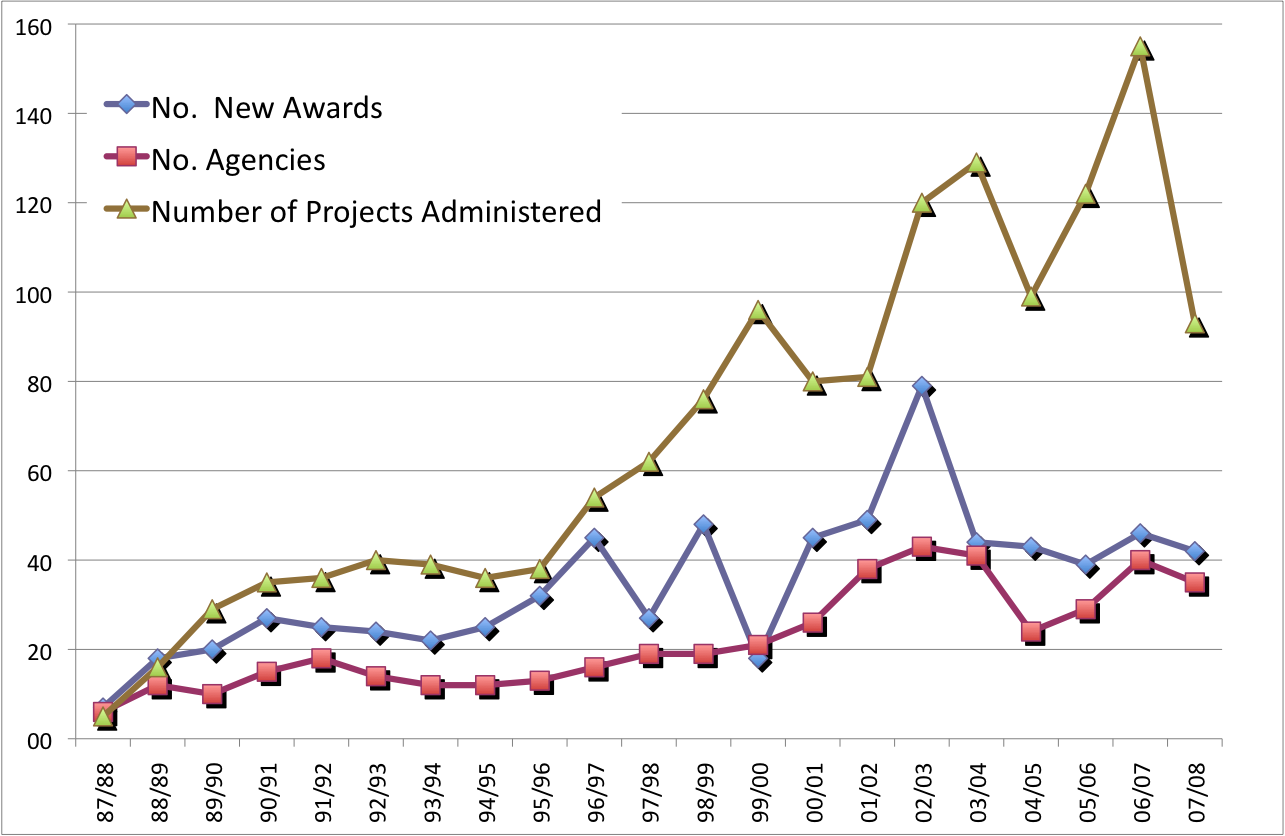
 through ICS, and this trend has been heightened by the decreasing number of soft-money research scientists at ICS. One ICS researcher
moved this past year to Johns Hopkins where she has a position partially funded by hard money. This continues a trend over the past 5
years with researchers moving to faculty positions at other universities. Therefore, despite a fairly steady level of external funding
and the number of new awards, the numbers of proposals submitted and the amount of funding requested showed substantial declines from
their recent peaks. The continued attrition of top-notch assistant researchers to high-quality institutions bespeaks the high standards
of achievement that characterize many of them. Such losses, however, represent a sustained drain on ICS resources and present a challenge
in building a cadre of researchers that can rise through the ranks and take on new leadership positions.
through ICS, and this trend has been heightened by the decreasing number of soft-money research scientists at ICS. One ICS researcher
moved this past year to Johns Hopkins where she has a position partially funded by hard money. This continues a trend over the past 5
years with researchers moving to faculty positions at other universities. Therefore, despite a fairly steady level of external funding
and the number of new awards, the numbers of proposals submitted and the amount of funding requested showed substantial declines from
their recent peaks. The continued attrition of top-notch assistant researchers to high-quality institutions bespeaks the high standards
of achievement that characterize many of them. Such losses, however, represent a sustained drain on ICS resources and present a challenge
in building a cadre of researchers that can rise through the ranks and take on new leadership positions.